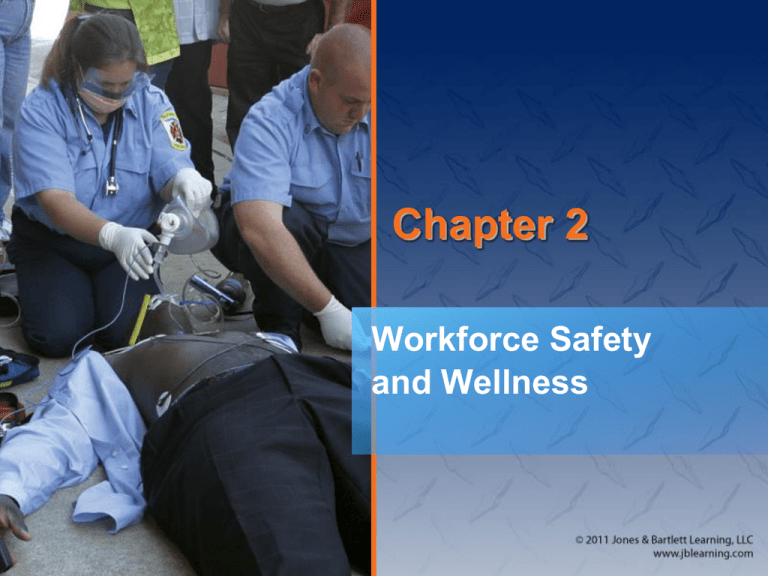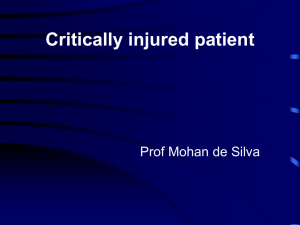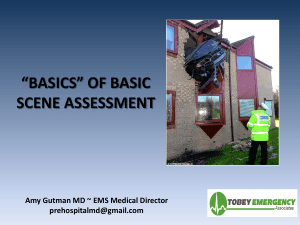Chapter 2 PPT
advertisement

Chapter 2 Workforce Safety and Wellness Introduction • To take care of others, we must take care of ourselves. • EMT training includes recognition of hazards: – Personal neglect – Health and safety hazards – Stress Infectious Diseases (1 of 2) • Infectious disease is caused by organisms within the body. • Communicable disease can be spread – From person to person – From one species to another Infectious Diseases (2 of 2) • Infection risk can be minimized by – Immunizations – Protective techniques – Handwashing (see Skill Drill 2-1) Routes of Transmission (1 of 2) Routes include: • Direct contact (eg, blood) • Indirect contact (eg, needlesticks) • Airborne transmission (eg, sneezing) • Vector-borne transmission (eg, fleas) • Foodborne transmission (eg, contaminated food) Routes of Transmission (2 of 2) • Example of direct contact Source: © DermQuest.com. Used with permission of Galderma S.A. Source: © James Klotz/ShutterStock, Inc. • Example of direct contact and airborne transmission Risk Reduction and Prevention for Infectious and Communicable Diseases (1 of 3) • All EMTs are trained in handling bloodborne pathogens. • CDC developed standard precautions: – Hand hygiene – Gloves – Gown Risk Reduction and Prevention for Infectious and Communicable Diseases (2 of 3) • Standard precautions (cont’d) – Mask, eye protection, face shield – Soiled patient care equipment – Environmental controls – Textiles and laundry – Needles and other sharp objects Risk Reduction and Prevention for Infectious and Communicable Diseases (3 of 3) • Standard precautions (cont’d) – Patient resuscitation – Respiratory hygiene/cough etiquette Proper Hand Hygiene (1 of 2) • Simplest yet most effective way to control disease transmission. • Wash hands before and after patient contact. Proper Hand Hygiene (2 of 2) • If there is no running water, use waterless handwashing substitute. Source: © Svanblar/ShutterStock, Inc. Gloves (1 of 2) • Wear if there is any possibility for exposure to blood or body fluids. • Both vinyl and latex are effective. Gloves (2 of 2) • Removing gloves requires a special technique. – To avoid contaminating yourself with materials from which the gloves have protected you (see Skill Drill 2-2) Gowns • Provide protection from extensive blood splatter • May not be practical in many situations – May even pose a risk for injury Eye Protection and Face Shields • Eye protection protects from blood splatters. • Prescription glasses are not adequate. • Goggles or face shields are best. Source: © Dr. P. Marazzi/Photo Researchers, Inc. Masks, Respirators, and Barrier Devices (1 of 2) • Standard surgical mask for fluid spatter • Surgical mask on patient with communicable disease – Mask with HEPA respirator on yourself if disease is tuberculosis Masks, Respirators, and Barrier Devices (2 of 2) • Mouth-to-mouth resuscitation may transmit disease • With an infected patient, use: – Pocket mask – Bag-mask device • Dispose of according to local guidelines Proper Disposal of Sharps • Avoid HIV and hepatitis – Do not recap, break, or bend needles. – Dispose of used sharp items in approved closed container. Establishing an Infection Control Routine (1 of 2) • Infection control should be part of your daily routine (see Skill Drill 2-3). • Clean the ambulance after each run and on a daily basis. • Cleaning should be done at the hospital whenever possible. Establishing an Infection Control Routine (2 of 2) Immunity • Even if germs reach you, you may not become infected. – You may be immune. • Preventive measures – Maintain your personal health. – Receive vaccinations. General Postexposure Management • If you are exposed to a patient’s blood or bodily fluids: – Turn over patient care to another EMS provider. – Clean the exposed area. – Rinse eyes if necessary. – Activate your department’s infection control plan. Stress Management on the Job (1 of 2) • EMS is a high-stress job. • Important to know causes and how to deal with stress • General adaptation syndrome: – Alarm response to stress – Reaction and resistance – Recovery—or exhaustion Stress Management on the Job (2 of 2) • Physiologic signs of stress – Increased respirations and heart rate – Increased blood pressure – Cool, clammy skin – Dilated pupils – Tensed muscles – Increased blood glucose level – Perspiration – Decreased blood flow to gastrointestinal tract Stressful Situations (1 of 2) • Dangerous situations • Physical and psychological demands • Critically ill or injured patients • Dead and dying patients • Overpowering sights, smells, and sounds Stressful Situations (2 of 2) • Multiple patient situations • Angry or upset patients, family, bystanders • Unpredictability and demands of EMS • Noncritical/non–9-1-1 patients Stress Reactions (1 of 2) • Acute stress reactions – Occur during a stressful situation • Delayed stress reactions – Manifest after stressful event • Cumulative stress reactions – Prolonged or excessive stress Stress Reactions (2 of 2) • Posttraumatic stress disorder (PTSD) can develop – Critical incident stress management (CISM) was developed to decrease likelihood of PTSD. Warning Signs of Stress (1 of 3) • Irritability toward coworkers, family, friends • Inability to concentrate • Sleep difficulties • Sadness, anxiety, or guilt • Indecisiveness Warning Signs of Stress (2 of 3) • Loss of appetite • Loss of interest in sexual activities • Isolation • Loss of interest in work • Increased use of alcohol • Recreational drug use Warning Signs of Stress (3 of 3) • Physical symptoms such as chronic pain – Headache – Backache • Feelings of hopelessness Strategies to Manage Stress (1 of 3) • Minimize or eliminate stressors. • Change partners to avoid a negative or hostile personality. • Change work hours. • Change the work environment. • Cut back on overtime. Strategies to Manage Stress (2 of 3) • Change your attitude about the stressor. • Talk about your feelings. • Seek professional counseling if needed. • Do not obsess over frustrations. • Try to adopt relaxed, philosophical outlook. Strategies to Manage Stress (3 of 3) • Expand social support system. • Sustain friends and interests outside emergency services. • Minimize physical response to stress – Deep breathing – Periodic stretching – Regular exercise Wellness and Stress Management (1 of 2) • Nutrition – Eat nutritious food. • Exercise and relaxation – Exercise regularly to promote fatigue for sleep. • Sleep – Regular and uninterrupted Source: Courtesy of USDA Wellness and Stress Management (2 of 2) • Disease prevention – Know family health history. – Adjust lifestyle. • Balancing work, family, and health – Rotate schedule. – Take time off. Workplace Issues (1 of 4) • Cultural diversity on the job – Each individual is different. – Communicate respectfully. – Use cultural diversity as a resource. Workplace Issues (2 of 4) • Cultural diversity on the job (cont’d) – Learn how to relate to people from different cultures. – Consider learning another language. Workplace Issues (3 of 4) • Sexual Harassment – Two types • Quid pro quo: request for sexual favors • Hostile work environment: jokes, touching, etc – Most complaints are of the second type. – Report harassment to supervisor immediately, and keep notes. Workplace Issues (4 of 4) • Substance Abuse – Increases risks on the job – Leads to poor decision making – Seek help, or find a way to confront an addicted coworker. – Employee assistance programs (EAPs) are often available. Emotional Aspects of Emergency Care • Personal reactions to difficult situations are difficult to overcome. • This is normal. • Every EMT must deal with these feelings. Death and Dying (1 of 5) • Death occurs: – Quite suddenly, or – After a prolonged, terminal illness • The EMT will face death. Source: © James Schaffer/PhotoEdit, Inc. Death and Dying (2 of 5) • Stages of grieving: – Denial – Anger, hostility – Bargaining – Depression – Acceptance Death and Dying (3 of 5) The EMT’s role: • Ask how you can help. • Reinforce reality. • Be honest. • Allow the patient/family to grieve. Death and Dying (4 of 5) • The EMT’s response to grief Death and Dying (5 of 5) • Concerns of dying, critically ill, or injured patients Caring for Critically Ill and Injured Patients (1 of 3) • Let the patient know who you are and what you are doing. Source: © Siphiwe Sibeko/Reuters/Landov • Let the patient know you are attending to his or her immediate needs. Caring for Critically Ill and Injured Patients (2 of 3) • Avoid sad and grim comments. • Orient the patient. • Be honest. • Deal with possible initial refusal of care. • Allow for hope. • Locate and notify family members. Caring for Critically Ill and Injured Patients (3 of 3) • Injured and critically ill children. – Ask a responsible adult to accompany child. • Death of a child – A tragic event. – Help the family in any way you can. Stressful Situations (1 of 2) • Many situations are stressful for everyone involved. • Use extreme care in words and actions. • Bring a sense of order and stability to the situation. Stressful Situations (2 of 2) • A patient’s reaction is influenced by many factors. • Allow patients to express fears and concerns. • Transport parents with their children. Uncertain Situations • If unclear if a true medical emergency exists: – Contact medical control about need to transport. – If in doubt, transport. Scene Safety (1 of 5) • Begin protecting yourself at dispatch and en route to the scene. Scene Safety (2 of 5) • Scene hazards – Hazardous materials • Identify what you can from a distance. • Do not enter unless safe to do so. Source: Courtesy of the U.S. Department of Transportation Scene Safety (3 of 5) • Scene hazards (cont’d) – Electricity • Beyond the scope of EMT training • Mark the danger zone – Lightning » A repeat strike can occur » Threat through direct hit or ground current Scene Safety (4 of 5) • Scene hazards (cont’d) Source: © Keith D. Cullom – Fire • Fire hazards include smoke, oxygen deficiency, high temperatures. • Use proper protection. Scene Safety (5 of 5) • Scene hazards (cont’d) – Vehicle collisions • Involve many factors • Unstable vehicles • Traffic • Sharp objects • Downed power lines – Use protective gear Protective Clothing: Preventing Injury (1 of 3) • Critical to personal safety. • Become familiar with various types: – Cold weather clothing • Three layers – Turnout gear • Heat, fire, sparks, and flashover Protective Clothing: Preventing Injury (2 of 3) • Types (cont’d) – Gloves • Heat, cold, cuts – Helmets • Falling objects – Boots • Steel-toed is preferred Protective Clothing: Preventing Injury (3 of 3) • Types (cont’d) – Eye protection • Glasses with side shield – Ear protection • Foam – Skin protection • Sunblock – Body armor • Vests Violent Situations (1 of 2) • Created by: – Civil disturbances – Domestic disputes – Crime scenes – Large gatherings of potentially hostile people Violent Situations (2 of 2) • Know who is in command. • Protect from dangers to provide care. – Law enforcement secures scene before your entry, or uses cover and concealment technique. • Do not disturb crime scene evidence. Behavioral Emergencies (1 of 2) • Emergencies that do not have a clear physical cause – Cause may turn out to be physical (eg, hypoglycemia, head trauma). • Result in aberrant behavior • Use caution. Behavioral Emergencies (2 of 2) • Principal determinants of violence: – Past history (check records) – Posture (tense, rigid) – Vocal activity (nature of speech) – Physical activity (motor activity)








